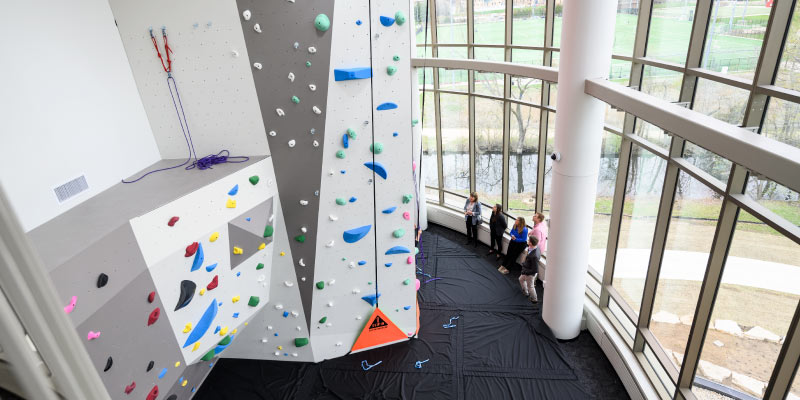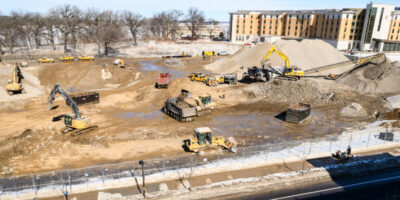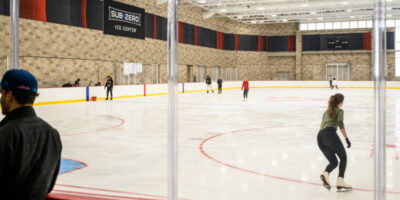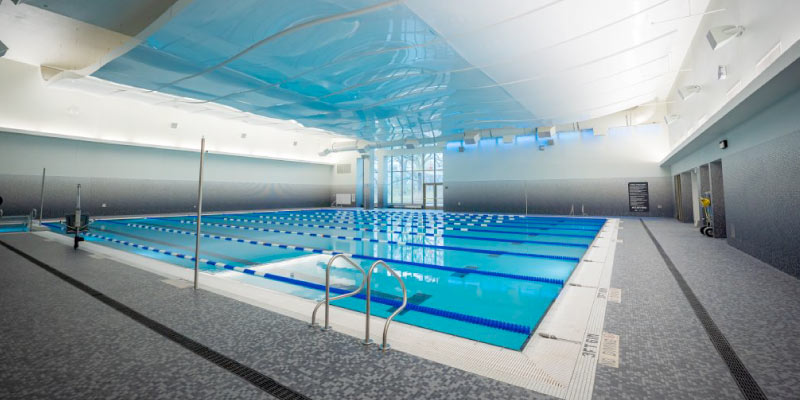
The UW–Madison campus is a place driven by change. From developing new technologies to unearthing groundbreaking discoveries, UW faculty, staff, and students are always looking for ways to make our existing world better. This mentality applies to the physical campus, as well. While some existing buildings see regular upgrades, others get the tear-it-down-and-start-over treatment — which is exactly what happened to the Natatorium, west campus’s fitness hub since the 1960s. Take a trip down Observatory Drive and you’ll see an impressive new structure in its place: the Bakke Recreation & Wellbeing Center. But the upgrade wasn’t just for looks; creating a sustainable and environmentally friendly building was at the forefront of the building’s design.

“Incorporating sustainable design and energy efficiency principles into our construction project was a top priority from the very beginning,” says Aaron Hobson, director of UW–Madison Recreation & Wellbeing (Rec Well). “These integrated principles were paramount in balancing costs, minimizing energy consumption and waste, and enhancing operational and maintenance practices.” Plus, the Bakke leans into the wellness half of Rec Well, with features including a teaching and demonstration kitchen, mirrorless yoga and meditation studios, and even nap pods.
In early 2020, members of the Rec Well team, students, and other university leaders participated in a workshop with the building’s lead architecture firms, HOK and Kahler Slater. Following a framework put in place by the American Institute of Architects’ Committee on the Environment, the group identified a series of sustainability goals for the building. Some of those goals included a target energy reduction of 60–65 percent, having the site be 15–30 percent native and low-maintenance vegetation, and a 30 percent water reduction through low-flow plumbing fixtures. According to Hobson, the building met or exceeded all of its targets.
But those certainly aren’t the only environmentally conscious features of the Bakke. Here are five of our favorite sustainable features at the Bakke Recreation & Wellbeing Center.

Electric Ice Resurfacers
You may be familiar with the word Zamboni — the street-sweeper–like machine that resurfaces an ice rink. But did you know that Zamboni is a name brand, and it’s not the only one out there? Not only does the Bakke Recreation & Wellbeing Center feature a new ice rink — the Sub-Zero Ice Center, which replaced the old Shell by Camp Randall — but it also traded Zambonis for Engo IceWolfs. While Zambonis run on propane, the IceWolfs are completely electric. “They run on a 80-volt lithium battery that allows for fast charging between ice resurfacings, and no dangerous gasses are released as with propane,” Hobson says. Fun fact: the new campus rink is the first ice rink in the state to own electric-powered ice resurfacers!
Construction Waste Diversion
When construction started for Bakke, crews didn’t take an “out with the old, in with the new” approach. What was old — the demolished Natatorium — started a journey to become new again. “Our goal in demolishing the 1960s building was to divert or recycle/reuse 95 percent of the materials from landfills,” says Hobson. “We achieved 99.71 percent.” Nearly 32,000 tons of materials, from concrete to metal to wood, were diverted, resulting in only 90.87 tons of solid waste.
Bird-Safe Glass
Positioned along the picturesque shores of Lake Mendota, the Bakke offers some of the most unparalleled nature views across campus. While you’re enjoying a treadmill walk, you can observe all sorts of flora and fauna through the building’s floor-to-ceiling windows — including numerous species of migratory and resident birds. If you’re thinking that bird habitats and a four-story building with floor-to-ceiling windows mightn’t be a good match, so were the minds behind Bakke. That’s why they installed bird-safe glass, an intervention developed in 2019 by students in the Office of Sustainability’s Green Fund program. The glass, which has a two-by-two grid pattern of small, semi-transparent dots, helps birds recognize the glass and prevents strike-related deaths.

Reusable Heat
On the building’s first floor, separated only by locker rooms and a hallway, are the Sub-Zero Ice Center and the eight-lane, 25-yard Cove Pool. This placement was intentional for a unique reason: to reuse heat. “Typically, when making and maintaining an ice sheet, heat is lost or expelled during the process through the ice mechanicals and chillers,” Hobson explains. “Instead of losing this valuable resource, the system at Bakke — through the use of three heat exchanges — allows the heat loss to be recovered.” Some of that recovered heat is captured and diverted below the facilities’ connecting hallway right to the water in the pool, keeping it heated.
Ho-Chunk Clan Circle
Perhaps one of the Bakke Recreation & Wellbeing Center’s most striking environmental features is outside on the building’s grounds. Positioned between the building and the lakeshore stands the Ho-Chunk Clan Circle, a series of 12 sculptures by Ho-Chunk artist Ken Lewis that pay homage to the 12 clans of the Ho-Chunk Nation — whose ancestral lands campus currently occupies. “The Ho-Chunk Clan Circle, right here adjacent to our newest recreational facility … was created as a reflection and educational space,” said Carla Vigue, tribal relations director in the Office of University Relations, at the circle’s dedication.